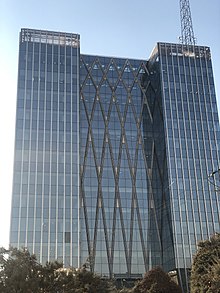Economy of Tehran

Tehran is the capital city and the main economic centre of Iran.[1] Tehran's present-day modern industries include the manufacturing of automobiles, electronics and electrical equipment, weaponry, textiles, sugar, cement, and chemical products. It is also a leading center for the sale of carpets and furniture.[2] The oil refining companies of Pars Oil, Speedy, and Behran are based in Tehran. Tehran hosts 45% of Iran's industries.[3]
Few foreign companies operate in Tehran, due to the government's complex international relations. But prior to the
Tehran Economy by Sector
Manufacturing and services

At the end of the twentieth century, more than one-third of all jobs in Tehran were related to social and personal services, also about one-fifth were in manufacturing and about one-sixth were in sales. construction, Transport and financial services each employed fewer workforce. Overall, services account for almost two-thirds of the workforce, Also fewer people employed in industrial activities and a negligible amount employed in agriculture.[1]
Manufacturing industries include metal machinery and equipment, textiles, chemicals, wood, mining, paper and basic metals.[1]
Fashion industry

Design, manufacturing, distribution, marketing, retail, advertising and other sectors of the fashion industry in Tehran have been able to grow significantly according to the needs of the country. In particular, a large number of male and female models are working in Tehran's fashion advertising and promotion sections. Despite the lack of adequate laws to support models, payments to female models have been considered high. Also, modeling of children is usually prohibited in Tehran. Clothing manufacturers are closely related to other fashion sectors in Tehran. For example, the manufacturers of women's boots and bodysuits have strengthened their exports and branding in other countries by using this connection.[5]
Energy
The country's economy is heavily dependent on oil and headquarters of one of the world's largest oil companies NIOC is located in Tehran.[6]
Tourism


Tehran is one of
There is also the
The
Media
Tehran is home to many international and regional
Creative industries and entertainment
Tehran creative arts sector comprises
Education and research
Tehran is the most prolific centers of higher education and research in the Middle East. The oldest modern university of the city, University of Tehran was established in 1934 and it is one of the most prestigious universities in Asia.[14][15]
Economic History of Tehran
After 1979 Revolution
Prior to the
See also
References
- ^ a b c "Tehrān | national capital, Iran". Encyclopedia Britannica. Retrieved 2018-07-09.
- ^ "Tehran - Economy". en.tehran.ir. Archived from the original on 2018-07-08. Retrieved 2018-07-09.
- ^ Anthony H. Cordesman (September 23, 2008). "The US, Israel, the Arab States and a Nuclear Iran. Part One: Iranian Nuclear Programs" (PDF). Center for Strategic and International Studies. Archived from the original (PDF) on August 6, 2010. Retrieved September 25, 2010.
- ISBN 978-0-7391-2677-6.
- ^ تاریخچه صنعت مد، پوشاک و شبکه توزیع وابسته در جهان و ایران (چاپ نخست) (in Persian). 2020. pp. 34, 35.
- ^ "NIOC". NIOC. Retrieved 2019-09-03.
- ^ "برج میلاد، بزرگترين رستوران گردان جهان و شام 168 هزارتومانی". fararu.com. Retrieved 2019-09-03.
- ^ "تهران، مقصدِ گردشگران". شورای اسلامی شهر تهران (in Persian). Retrieved 2018-12-30.
- ISSN 0261-3077. Retrieved 2018-12-30.
- ^ "تهران میزبان ۱.۶ میلیون گردشگر خارجی". اقتصاد آنلاین (in Persian). Retrieved 2018-12-30.
- ^ "ایران: آثار موزه هنرهای معاصر را به خارج نمیفرستیم". BBC (in Persian). 2017-06-17. Retrieved 2019-01-30.
- ^ "mizanonline". www.mizanonline.com. Retrieved 2019-09-03.
- ^ "آغاز فعالیت هفتمین جشنواره فیلم شهر". ایسنا (in Persian). 2019-07-18. Retrieved 2019-09-03.
- ^ "Tehrān - Administration and social conditions". Encyclopedia Britannica. Retrieved 2019-09-03.
- ^ "آشنایی با دانشگاه تهران". همشهری آنلاین (in Persian). 2008-05-13. Retrieved 2019-09-03.
- ^ "همه قراردادهای ایران با شرکتهای خارجی در ۱۸ ماه اجرای برجام". مشرق نیوز (in Persian). 2017-08-22. Retrieved 2019-09-03.
External links
- Tehran official website Archived 2017-05-03 at the Wayback Machine
